What is a frozen shoulder?
A frozen shoulder is a condition characterized by inflammation, scarring and tightening of the connective tissue surrounding the shoulder joint, usually resulting in shoulder pain and a marked loss of shoulder movement.
What happens in frozen shoulder?
The shoulder joint capsule may become inflamed with subsequent tightening and scarring of the shoulder joint capsule. When this occurs, it will results in a marked loss of shoulder range of movement. Frozen shoulder can generally be divided into 3 phases, each of which can last a number of months:
-
Pain : In this first phase of a frozen shoulder, the shoulder typically becomes painful with most movements. The shoulder may also start to stiffen during this phase.
-
Freezing : During the second phase, the condition usually is characterized by a marked loss of movement of the shoulder, coinciding with scarring of the shoulder joint capsule. Patients typically experience difficulty when elevating the arm or taking their hand behind their back. Pain may decrease noticeably during this phase.
-
Thawing : At the final phase, the shoulder spontaneously begins to ‘loosen’ up and movement to the shoulder is gradually restored.
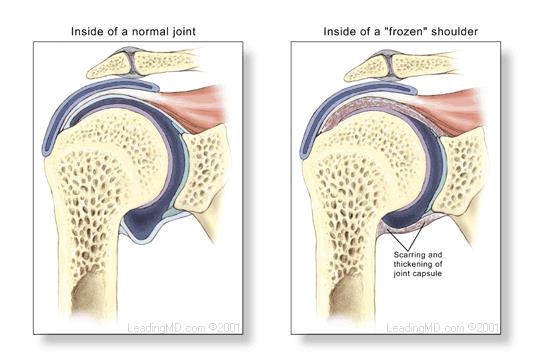 |
| Source: http://harrys-frozenshoulder.blogspot.com/ |
What are the signs and symptoms of frozen shoulder?
The main signs and symptoms of a frozen shoulder include pain, stiffness, and loss of range of motion of the shoulder. The shoulder can develop increased pain with use. Reluctance in doing optimum activity leads to limitation of the shoulder range of motion. These symptoms can make sleep very uncomfortable. Limitation of the physical activity drops the person’s quality of life.
What are the risk factors for frozen shoulder?
Most often, frozen shoulder occurs with no associated injury or discernible cause. However, there are some common themes in many patients who develop this condition:
-
Age – Most commonly affects patients between the ages of 40 to 60 years old.
-
Gender – It is much more common in women than in men. 70% of people with frozen shoulder are women.
-
Shoulder/Arm trauma or surgery – The person with a history of shoulder injury or surgery has an increased risk to develop frozen shoulder. When injury or surgery is followed by prolonged joint immobilization, the risk of developing a frozen shoulder is highest. Immobility of recovery may cause the shoulder capsule to stiffen.
-
Diabetes – Diabetics are two to four times more likely to develop frozen shoulder for unknown reasons; symptoms may be more severe.
-
Having suffered a stroke.
-
Other systemic conditions – Several systemic conditions such as heart disease and Parkinson’s disease have also been associated with an increased risk for developing a frozen shoulder.
-
Endocrine Disorders – Patients with diabetes are at particular risk for developing a frozen shoulder. Other endocrine abnormalities, such as thyroid problems eg Hyperthyroidism (overactive thyroid) or Hypothyroidism (underactive thyroid) can also lead to development of this condition.
What you need to do during early stage of frozen shoulder?
Provide initial relief of pain with the following regimen:
-
Protection Avoid from doing the strenuous activity involving the shoulder.
-
Rest Adequate rests need to be taken, stop doing any strenuous activity such as lifting or transferring the heavy objects.
-
Ice Applied up to 15 minutes for several times per day. Ice massage and cold packs will improve shoulder joint range, function and strength and decrease swelling. Some patients prefer the moist heat for pain relief.
-
Compression If swelling exists, wrapping with an elastic bandage can improve the circulation.
What is the physiotherapy management for frozen shoulder?
-
Modalities
-
Heat and cold therapy is applied to enhance relaxation and reduce pain. It is important to use ice after exercise and after any activity that causes discomfort. Pulsed electrical stimulation can also be used to relieve the pain. Electric stimulation will helps to improve the blood circulation, thus enhancing the healing process and reducing any swelling or discomfort.
-
-
Exercise
-
Stretching and strengthening exercises need to be done regularly. Exercises will restore the movement and maintain the adequate strength and stability of the shoulder joint.
-
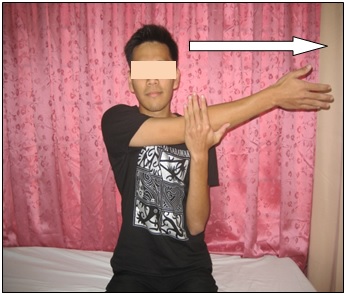 |
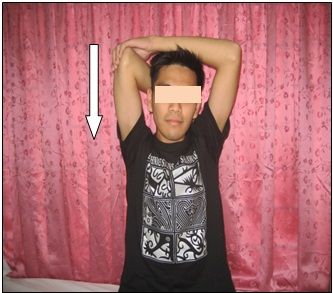 |
| Self-stretching of shoulder muscle | Self-stretching of triceps |
|
|
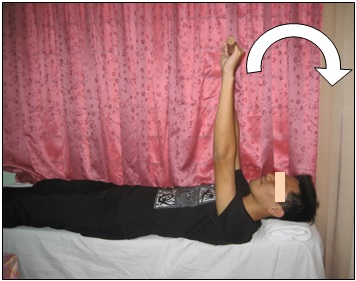 |
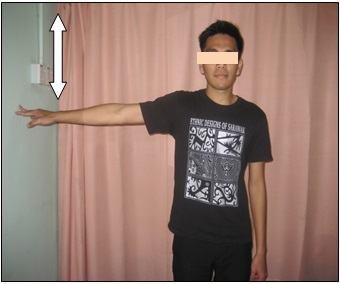 |
| Assisted mobilizing shoulder exercise (with stick) | Self-mobilizing shoulder exercise |
|
|
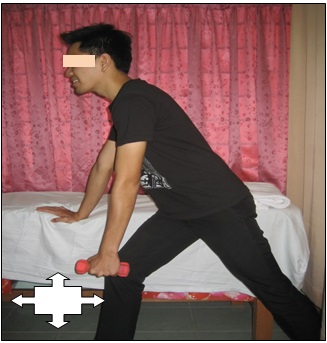 |
 |
| Self pendular shoulder exercise (with weight) | Loaded shoulder strengthening (wall push up) |
|
|
| Source: Unit Fisioterapi Hospital Raja Perempuan Zainab II, Kota Bharu |
-
Advice to patient
-
Avoid excessive overhead activities such as throwing
-
Avoid repetitive overhead movements and weight lifting such as military press
-
Always s trengthen your shoulders and do not try to play or work through the pain
-
Remember to develop strength of opposing muscle groups of the shoulder
-
Sleep with the arm over or behind your head to prevent shoulder impingement
-
How can frozen shoulder be prevented?
Frozen shoulder can only be prevented if it is caused by an injury that makes shoulder movement difficult, in which case the patient should talk to a physiotherapist about what exercises can maintain mobility and flexibility of the shoulder joint.
References
-
Caroline Gillott (2009) What is frozen shoulder? What causes frozen shoulder? http://www.medicalnewstoday.com
-
Jonathan Cluett (2013) Frozen shoulder : Stiffness and pain of the shoulder joint http://orthopedics.about.com
-
William C. Shiel Jr. & Catherine Burt Driver (2014) Frozen shoulder (Adhesive capsulitis) http://www.onhealth.com
-
Prodyut Das (2014) Frozen shoulder exercises http://www.physiotherapy-treatment.com
Source image
-
(2013) http://harrys-frozenshoulder.blogspot.com/Retrieved February 3, 2014.
-
(2014) Unit Fisioterapi, Hospital Raja Perempuan Zainab II, Kota Bharu. Retrieved February 3, 2014.
| Last Reviewed | : | 23 August 2019 |
| Writer / Translator | : | Halimah binti Hashim |
| Accreditor | : | Daaljit Singh a/l Harbachan Singh |
| Reviewer | : | Halimah bt. Hashim |







